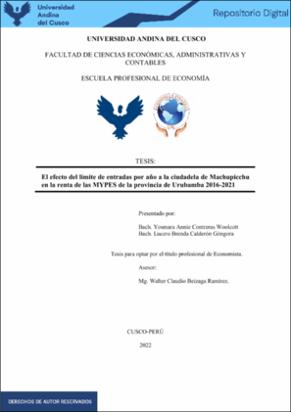| dc.contributor.advisor | Beizaga Ramírez, Walter Claudio | |
| dc.contributor.author | Contreras Woolcott, Yosmara Annie | |
| dc.contributor.author | Calderón Góngora, Lucero Brenda | |
| dc.date.accessioned | 2023-05-16T15:00:22Z | |
| dc.date.available | 2023-05-16T15:00:22Z | |
| dc.date.issued | 2022-12-15 | |
| dc.identifier.uri | https://hdl.handle.net/20.500.12557/5432 | |
| dc.description.abstract | La ciudadela de Machupicchu es el principal destino turístico del Perú, con más de 120
mil visitas anuales el año 2019. Sin embargo, en la última década, la ciudadela ha
alcanzado la capacidad máxima de visitas diarias sin causar daño material o impactos
negativos de mediano plazo y largo plazo sobre la Llaqta. En este sentido, la presente
investigación tiene el objetivo de determinar el efecto del límite de entradas por año a la
ciudadela de Machupicchu en la renta de las MYPES de la provincia de Urubamba
durante el período 2016-2021. Para ello, se utiliza información de 181 trabajadores
independientes (MYPES) encuestadas por INEI en el Cuestionario del Trabajador
Independiente. La investigación tiene un alcance explicativo, con un diseño no
experimental y de tipo descriptivo correlacional. Los resultados principales encuentran
que las rentas de las MYPES disminuyeron de 725 soles mensuales a 524 soles mensuales
entre el 2016 y el 2021 (p < 0.10). La reducción se debe al límite de entradas por año a la
ciudadela de Machupicchu y el cierre total de la ciudadela durante los meses de Marzo -
Noviembre del 2020. Se estima que el cierre redujo las rentas mensuales hasta en 10
puntos porcentuales (p < 0.10). También se ha identificado que los costos de las MYPES
se incrementaron hasta en un 74% por el límite de entradas por año a la ciudadela de
Machupicchu y el cierre total de la ciudadela durante los meses de Marzo - Noviembre
del 2020 (p < 0.10). Por último, las causas que influyeron en la política de límite de
entradas incluyen el sobreturismo en la ciudadela de Machupicchu, en particular, son los
dos cambios en la normativa que regula las visitas a la ciudadela en 2017 y 2020 sugiere
que se presentaban efectos negativos de mediano/largo plazo. Los efectos directos
incluyen una reducción de la renta de 201 soles y un incremento de los costos
operacionales de hasta un 74% de las MYPES durante el período estudiado (p < 0.10). | es_PE |
| dc.description.abstract | The citadel of Machupicchu is the main tourist destination in Peru, with more than
120,000 annual visits in 2019. However, in the last decade, the citadel has reached the
maximum capacity of daily visits without causing material damage or medium negative
impacts. In this sense, the present investigation has the objective of determining the effect
of the limit of entries per year to the citadel of Machupicchu on the income of the MYPES
of the province of Urubamba during the period 2016-2021. To do this, information from
181 independent workers (MYPES) surveyed by INEI in the Independent Worker
Questionnaire is used. The research has an explanatory scope, with a non-experimental
and descriptive correlational design. The main results find that the income of the MYPES
decreased from 725 soles per month to 524 soles per month between 2016 and 2021. The
reduction is due to the limit of entries per year to the citadel of Machupicchu and the total
closure of the citadel during the months of March - November 2020. It is estimated that
the closure reduced monthly rents by up to 10 percentage points. It has also been
identified that the costs of the MYPES increased by up to 74% due to the limit of entries
per year to the citadel of Machupicchu and the total closure of the citadel during the
months of March - November 2020. Finally, the causes that influenced the entry limit
policy include overtourism in the citadel of Machupicchu are the two changes in the
regulations that regulate visits to the citadel in 2017 and 2020 suggest that there were
medium / long negative effects term. The direct effects include a reduction in income and
an increase in the operating costs of the MYPES during the period studied. | en_US |
| dc.format | application/pdf | es_PE |
| dc.language.iso | spa | es_PE |
| dc.publisher | Universidad Andina del Cusco | es_PE |
| dc.rights | info:eu-repo/semantics/openAccess | es_PE |
| dc.rights.uri | https://creativecommons.org/licenses/by-nc-nd/4.0/ | es_PE |
| dc.subject | Ciudadela inca | es_PE |
| dc.subject | Turismo | es_PE |
| dc.subject | Boletaje | es_PE |
| dc.title | El efecto del límite de entradas por año a la ciudadela de Machupicchu en la renta de las MYPES de la provincia de Urubamba 2016-2021 | es_PE |
| dc.type | info:eu-repo/semantics/bachelorThesis | es_PE |
| thesis.degree.name | Economista | es_PE |
| thesis.degree.grantor | Universidad Andina del Cusco. Facultad de Ciencias Económicas, Administrativas y Contables | es_PE |
| thesis.degree.discipline | Economía | es_PE |
| dc.publisher.country | PE | es_PE |
| dc.subject.ocde | https://purl.org/pe-repo/ocde/ford#5.02.01 | es_PE |
| renati.advisor.dni | 23821642 | |
| renati.advisor.orcid | https://orcid.org/0000-0001-9232-2063 | es_PE |
| renati.author.dni | 70011619 | |
| renati.author.dni | 70413404 | |
| renati.discipline | 311016 | es_PE |
| renati.juror | Quispe Palomino, Alberto | |
| renati.juror | Lopez Garces, Oscar Israel | |
| renati.juror | Florez Lucana, Ignacio Ramiro | |
| renati.juror | Vargas Gibaja, Aurelio | |
| renati.level | https://purl.org/pe-repo/renati/level#tituloProfesional | es_PE |
| renati.type | https://purl.org/pe-repo/renati/type#tesis | es_PE |


